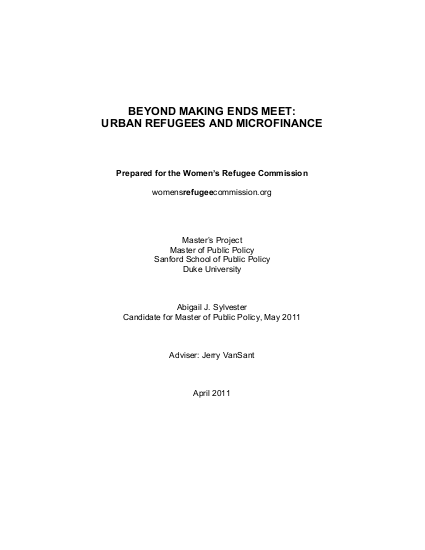
The purpose of this paper is to determine the types of programs, partnerships and policies UNHCR should support to improve microcredit and microsavings for urban refugees in the informal economy. I set out to accomplish this purpose in partnership with the Women’s Refugee Commission, an evidence-based advocacy organization that advocates vigorously for laws, policies and programs to improve the lives and protect the rights of refugee and internally displaced women, children and young people, including those seeking asylum—bringing about lasting, measurable change. Though independent, WRC often collaborates with UNHCR and other stakeholders to determine better practices and approaches for protecting refugees, especially women and youth.
There are approximately 10.5 million refugees worldwide, more than half of who live in urban areas and only a third in camps.1 Refugees in protracted situations make up 68% of the refugee population, meaning they are not sure when or if they will return home. The average length of their displacement is 17 years, hardly a length of time appropriate for short-term, humanitarian interventions.2 The trend of urbanization does not apply exclusively to refugees. More than half of the world’s population lives in urban areas, 1.5 billion living in poor urban and slum areas.
Urban refugees typically live in the same communities as urban poor. Both groups operate primarily in the informal economy, face bribery and harassment from police, and have inadequate social safety nets such as healthcare, education and housing. Women are particularly vulnerable to exploitation and gender-based violence under these circumstances. Refugees face additional challenges as they often do not have proper documentation, clear legal status or rights to work or movement as do their host neighbors. These challenges result in additional protection concerns and obstacles to generating an income and becoming self-reliant.
Microcredit and microsavings are approaches that development actors are exploring to help protect and reduce poverty among urban poor, but urban refugees are often left out of these microfinance schemes. Refugees have expressed the need for microcredit to grow their informal businesses, and microsavings schemes to help establish financial security. Utilizing financial services could help many refugees achieve self-reliance.
I identified four categories where UNHCR can support microfinance: partnerships, programming, policy and evaluation and advocacy. I developed nine different options within these categories and analyzed them against three criteria: ensure political feasibility, consider UNHCR’s financial limitations, balance refugee protection concerns with economic stability. I ultimately recommend all nine options for UNHCR to consider for implementation.
Resource collections
- Accountability to affected populations (AAP)
- UN Habitat - Urban Response Collection
- Urban Response - Urban Crisis Preparedness and Risk Reduction
- Urban Response Collection - Community Engagement and Social Cohesion
- Urban Response Collection - Economic Recovery
- Urban Response Collection - Environment and Climate Change
- Urban Response Collection - Housing, Land and Property
- Urban Response Collection - Urban Crisis Response, Recovery and Reconstruction
- Urban Response Collection - Urban Resilience